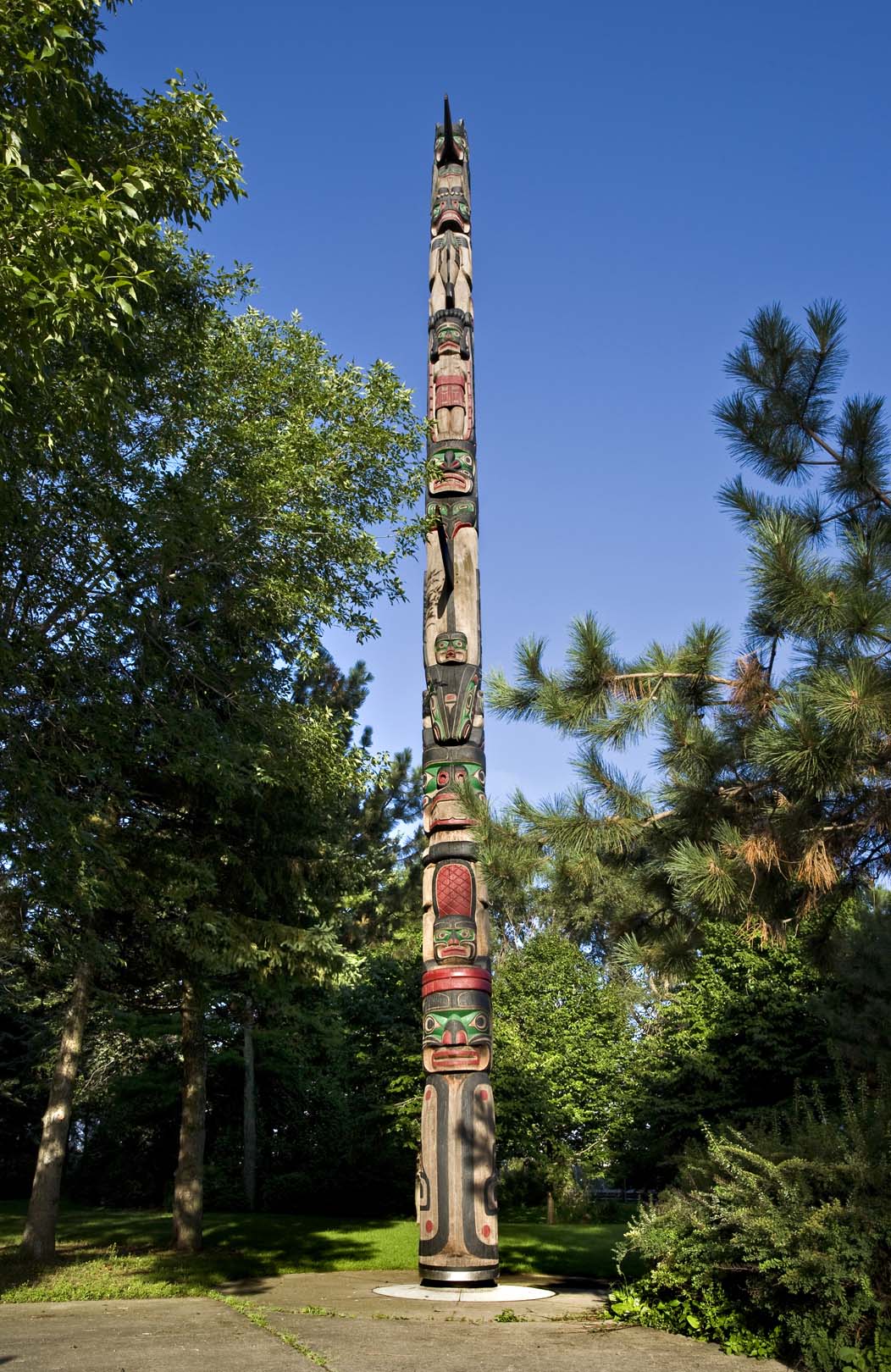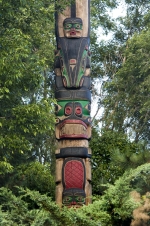Henry Hunt, Tony Hunt
Totem Kwakiutl
1967
Presentation of the artwork
Since 1967, the 21.3-metre-high Kwakiutl totem pole has acted as a reference point on Île Notre-Dame. Sculpted from a red-cedar trunk, it comprises six mythological figures placed vertically: Gwa’wis (Sea Crow), Gila (Grizzly Bear and Salmon), Sisiutl (Two-headed Snake), Makhinukhw (Killer Whale with Seal in Its Mouth), Tsawi (Beaver), and Numas (Old Man). Some sections of the pole are painted red, green, or black, whereas other sections have been left unpainted.The Kwakiutl totem pole differs from poles traditionally erected on reserves in that it was a commission from outside of Aboriginal culture for the 1967 World Fair. It was produced in relation to the aesthetic code in force on the Pacific Northwest coast. The six mythological figures portrayed are emblems of a number of KwaKwaka'wakw clans and do not draw on a particular family line, in order to illustrate that all of these clans are acting together.
Associated events
The artwork was an integral part of the concept for the Canadian Indians pavilion at the 1967 World Fair. Today, it is the only remaining vestige of the pavilion, which recognized the contribution of Indigenous nations to Canadian society and the unique nature of their cultures.
At the inauguration of the artwork, on 10 February 1967, a ceremony in the Kwakiutl tradition complemented the official speeches.
Henry Hunt
Born in Fort Rupert, British Columbia, Henry Hunt (1923–85) was known for his carved sculptures and research on all forms of art of Pacific coast Indigenous cultures. Between 1962 and 1974, he was chief sculptor at the Royal British Columbia Museum, where his son, Tony, served as his assistant. During their careers, the two men created, together or individually, numerous totem poles that are on display all over the world. For example, in 1970 they jointly produced a totem pole for the Osaka World Fair.
The Hunts were trained through the passing of knowledge from generation to generation, reaching back to Charlie James, a renowned late-nineteenth-century artist known for having created a style specific to the Kwakiutl of Fort Rupert. His son-in-law, Mungo Martin, was exceptionally talented and one of the great master sculptors of the Pacific coast. He transmitted his knowledge, technique, and art to his son-in-law, Henry Hunt, and his grandson, Tony. Tony Hunt was also the founder of Arts of the Raven Gallery, an organization devoted to teaching young Aboriginal sculptors.
The Hunts were trained through the passing of knowledge from generation to generation, reaching back to Charlie James, a renowned late-nineteenth-century artist known for having created a style specific to the Kwakiutl of Fort Rupert. His son-in-law, Mungo Martin, was exceptionally talented and one of the great master sculptors of the Pacific coast. He transmitted his knowledge, technique, and art to his son-in-law, Henry Hunt, and his grandson, Tony. Tony Hunt was also the founder of Arts of the Raven Gallery, an organization devoted to teaching young Aboriginal sculptors.
Tony Hunt
Born in Fort Rupert, British Columbia, Henry Hunt (1923–85) was known for his carved sculptures and research on all forms of art of Pacific coast Indigenous cultures. Between 1962 and 1974, he was chief sculptor at the Royal British Columbia Museum, where his son, Tony, served as his assistant. During their careers, the two men created, together or individually, numerous totem poles that are on display all over the world. For example, in 1970 they jointly produced a totem pole for the Osaka World Fair.
The Hunts were trained through the passing of knowledge from generation to generation, reaching back to Charlie James, a renowned late-nineteenth-century artist known for having created a style specific to the Kwakiutl of Fort Rupert. His son-in-law, Mungo Martin, was exceptionally talented and one of the great master sculptors of the Pacific coast. He transmitted his knowledge, technique, and art to his son-in-law, Henry Hunt, and his grandson, Tony. Tony Hunt was also the founder of Arts of the Raven Gallery, an organization devoted to teaching young Aboriginal sculptors.
The Hunts were trained through the passing of knowledge from generation to generation, reaching back to Charlie James, a renowned late-nineteenth-century artist known for having created a style specific to the Kwakiutl of Fort Rupert. His son-in-law, Mungo Martin, was exceptionally talented and one of the great master sculptors of the Pacific coast. He transmitted his knowledge, technique, and art to his son-in-law, Henry Hunt, and his grandson, Tony. Tony Hunt was also the founder of Arts of the Raven Gallery, an organization devoted to teaching young Aboriginal sculptors.
Presentation of the artwork
Since 1967, the 21.3-metre-high Kwakiutl totem pole has acted as a reference point on Île Notre-Dame. Sculpted from a red-cedar trunk, it comprises six mythological figures placed vertically: Gwa’wis (Sea Crow), Gila (Grizzly Bear and Salmon), Sisiutl (Two-headed Snake), Makhinukhw (Killer Whale with Seal in Its Mouth), Tsawi (Beaver), and Numas (Old Man). Some sections of the pole are painted red, green, or black, whereas other sections have been left unpainted.The Kwakiutl totem pole differs from poles traditionally erected on reserves in that it was a commission from outside of Aboriginal culture for the 1967 World Fair. It was produced in relation to the aesthetic code in force on the Pacific Northwest coast. The six mythological figures portrayed are emblems of a number of KwaKwaka'wakw clans and do not draw on a particular family line, in order to illustrate that all of these clans are acting together.
Associated events
The artwork was an integral part of the concept for the Canadian Indians pavilion at the 1967 World Fair. Today, it is the only remaining vestige of the pavilion, which recognized the contribution of Indigenous nations to Canadian society and the unique nature of their cultures.
At the inauguration of the artwork, on 10 February 1967, a ceremony in the Kwakiutl tradition complemented the official speeches.
Henry Hunt
Born in Fort Rupert, British Columbia, Henry Hunt (1923–85) was known for his carved sculptures and research on all forms of art of Pacific coast Indigenous cultures. Between 1962 and 1974, he was chief sculptor at the Royal British Columbia Museum, where his son, Tony, served as his assistant. During their careers, the two men created, together or individually, numerous totem poles that are on display all over the world. For example, in 1970 they jointly produced a totem pole for the Osaka World Fair.
The Hunts were trained through the passing of knowledge from generation to generation, reaching back to Charlie James, a renowned late-nineteenth-century artist known for having created a style specific to the Kwakiutl of Fort Rupert. His son-in-law, Mungo Martin, was exceptionally talented and one of the great master sculptors of the Pacific coast. He transmitted his knowledge, technique, and art to his son-in-law, Henry Hunt, and his grandson, Tony. Tony Hunt was also the founder of Arts of the Raven Gallery, an organization devoted to teaching young Aboriginal sculptors.
The Hunts were trained through the passing of knowledge from generation to generation, reaching back to Charlie James, a renowned late-nineteenth-century artist known for having created a style specific to the Kwakiutl of Fort Rupert. His son-in-law, Mungo Martin, was exceptionally talented and one of the great master sculptors of the Pacific coast. He transmitted his knowledge, technique, and art to his son-in-law, Henry Hunt, and his grandson, Tony. Tony Hunt was also the founder of Arts of the Raven Gallery, an organization devoted to teaching young Aboriginal sculptors.
Tony Hunt
Born in Fort Rupert, British Columbia, Henry Hunt (1923–85) was known for his carved sculptures and research on all forms of art of Pacific coast Indigenous cultures. Between 1962 and 1974, he was chief sculptor at the Royal British Columbia Museum, where his son, Tony, served as his assistant. During their careers, the two men created, together or individually, numerous totem poles that are on display all over the world. For example, in 1970 they jointly produced a totem pole for the Osaka World Fair.
The Hunts were trained through the passing of knowledge from generation to generation, reaching back to Charlie James, a renowned late-nineteenth-century artist known for having created a style specific to the Kwakiutl of Fort Rupert. His son-in-law, Mungo Martin, was exceptionally talented and one of the great master sculptors of the Pacific coast. He transmitted his knowledge, technique, and art to his son-in-law, Henry Hunt, and his grandson, Tony. Tony Hunt was also the founder of Arts of the Raven Gallery, an organization devoted to teaching young Aboriginal sculptors.
The Hunts were trained through the passing of knowledge from generation to generation, reaching back to Charlie James, a renowned late-nineteenth-century artist known for having created a style specific to the Kwakiutl of Fort Rupert. His son-in-law, Mungo Martin, was exceptionally talented and one of the great master sculptors of the Pacific coast. He transmitted his knowledge, technique, and art to his son-in-law, Henry Hunt, and his grandson, Tony. Tony Hunt was also the founder of Arts of the Raven Gallery, an organization devoted to teaching young Aboriginal sculptors.






